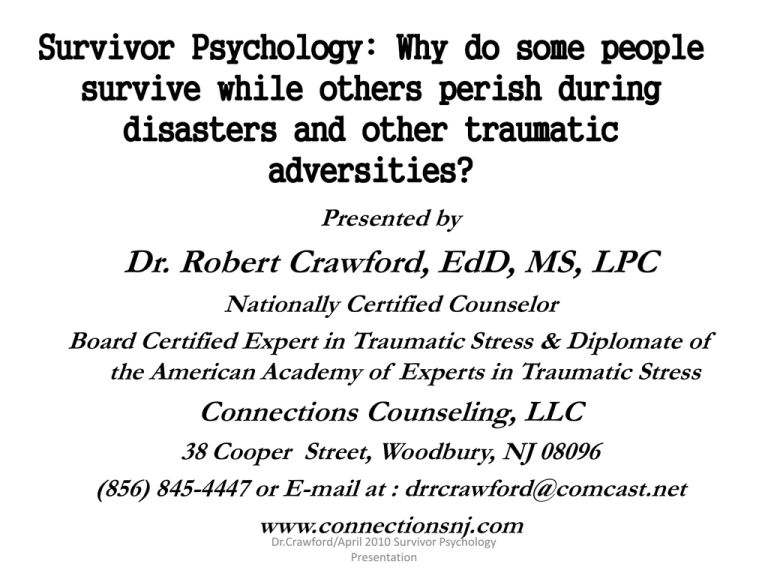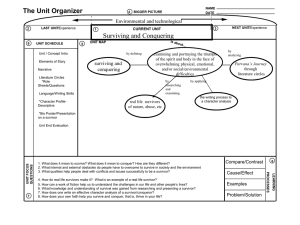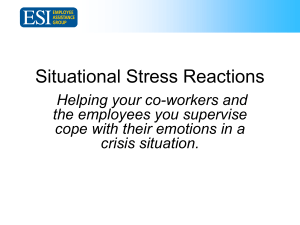Survivor Psychology-PowerPT Presentation-April
advertisement

Survivor Psychology: Why do some people survive while others perish during disasters and other traumatic adversities? Presented by Dr. Robert Crawford, EdD, MS, LPC Nationally Certified Counselor Board Certified Expert in Traumatic Stress & Diplomate of the American Academy of Experts in Traumatic Stress Connections Counseling, LLC 38 Cooper Street, Woodbury, NJ 08096 (856) 845-4447 or E-mail at : drrcrawford@comcast.net www.connectionsnj.com Dr.Crawford/April 2010 Survivor Psychology Presentation Understanding Trauma Trauma defined is the experiencing, witnessing, or confrontation of an event(s) that involvled actual or threatened death, or serious injury to the physical integrity of self or others wherin the person’s response involved helplessness, horror or FEAR. Trauma manifests in Four domains; Physical reactions/Mental reactions/Emotional reactions/ Behavioral reactions Dr.Crawford/April 2010 Survivor Psychology Presentation Understanding Trauma When our survival is threatened, when disaster strikes or is impending, our typical response is fear…….and how we respond to our fears determines who among us survives…..and if we survive who develops a trauma response as opposed to who overcomes and emotionally survives the experience. It is our understanding of our Fear response that is the key variable in our Survival. Research across the fields related to Survival Psychology clearly assert there are only two approaches to successfully reduce the Fearresponse…Realistic Rehearsal (Training) & Faith! Dr.Crawford/April 2010 Survivor Psychology Presentation Understanding Trauma Our survival response is a complex behavioral, bio-neurological response that is instinctual, instantaneous, and mostly unconscious…… We see it as the fight/flight/freeze response Leach’s Theory of 10-80-10 (Sherwood,2009) Fear is primitive and it short-circuits our higher level brain functioning (Ripley, 2009)…..so when fear is present our emotions overide our reasoning and cognitive skills…..fear kills! Dr.Crawford/April 2010 Survivor Psychology Presentation Understanding Trauma During a Fear reaction……… 1. The amygdala is triggered and neural networks and chemical compounds are activated and released! Adrenalin (epinephrine) is released from the adrenal glands. Epinephrine and norepinephrine ( called catecholamines) released excites the sympathetic nervous system! 2. The hippocampus is attacked by the stress-released cortisol which impedes the working of the pre-frontal cortex...this is where memory, attention, perception is all processed..so our higher functioning brain crashes! Dr.Crawford/April 2010 Survivor Psychology Presentation Understanding Trauma Our brains are structured into three main parts: 1. the cortex (the outer surface, where higher thinking skills arise; includes the frontal cortex, the most recently evolved portion of the brain) 2. the limbic system (the center of the brain, where emotions evolve) 3. the brain stem (the reptilian brain that controls basic survival functions) • trauma actually changes the structure and function of the brain, at the point where the frontal cortex, the emotional brain and the survival brain converge. Dr.Crawford/April 2010 Survivor Psychology Presentation tion Special Considerations for Children/Teens after a traumatic event. • Traumatic life events are fairly common in childhood. Research suggests that 14 to 43% of children have experienced at least one traumatic event in their lifetime. • There is a wide range of responses to catastrophic events. Some children and teenagers experience temporary worries and fears that get better quickly. Others experience long-term problems such as fear, depression, withdrawal, anger, haunting memories, avoiding reminders of the event, regressive behavior (acting younger than their actual age), worrying about themselves and others dying or being hurt, and irritability. Reactions can occur immediately Cite: www. Istss.org Dr.Crawford/April 2010 Survivor Psychology Presentation Special Considerations for Children/Teens after a traumatic event. • Young children (age 5 and younger) may experience new fears such as separation anxiety or fear of strangers or animals. They may act younger or lose a skill they have already mastered (such as toilet training). • Elementary school-aged children (6 to 11) may get parts of the traumatic experience confused or out of order when recalling the memory. They may complain of body symptoms that have no medical cause(e.g., stomach aches). They may stare into space or seem “spacey,” or startle easily. • Adolescents (12 to 18) may experience visual, auditory, or bodily flashbacks of the events, have unwanted distressing thoughts or images of the events, demonstrate impulsive and aggressive behaviors, or use alcohol or drugs to try to feel better. They may feel depressed or have suicidal thoughts. Dr.Crawford/April 2010 Survivor Psychology Presentation Response and Resiliency Psychological Resiliency is defined as “effective coping and adaptation although faced with loss, hardship, or adversity” (Tugade & Fredrickson, 2004) Psychological Resiliency is a mindset that is preestablished based on a Mental Triology of emotions, cognitions, and motivations. (Gonzales, 2003, p 219) Psychological Resiliency is the product of a worldview, personal characteristics and a way of positive thinking, proactive training &planning, and faith in a Higher Purpose to one’s life. Dr.Crawford/April 2010 Survivor Psychology Presentation Response and Resiliency Individuals who are Psychological Resilient use the following to respond & recover: 1) Positive coping strategies that include positive reappraisal with positive meaning ( creating a NEW NARARTIVE ) 2) They are self-confidence that they influence life events! This is key for two critical points: Self-confident people secret less cortisol when under stress AND they react faster in the moment…less likely to succumb to F/F/F 3) They find meaning in their adversity tied to a Higher Purpose 4) A conviction that they can learn from both the negative & positive experiences in both life’s turmoil and adversity 5) They don’t deny the danger in the crisis moment/see training info Dr.Crawford/April 2010 Survivor Psychology Presentation Response and Resiliency Adversarial Growth defined as “the process of struggling with adversity that changes may arise that propel an individual to a higher level of functioning than which existed prior to the event.” (Linley & Joseph, 2004, p.11.) OR Posttraumatic Growth explained as the experience of growth emerging from the struggle of life’s greatest difficulties across 5 life domains; seeing new possibilities, changed relationships, viewing self as both stronger yet more vulnerable, greater appreciation for life, and changes in one’s spiritual perspective. (Calhoun&Tedeschi, 2004) Dr.Crawford/April 2010 Survivor Psychology Presentation Special Considerations for Children/Teens after a traumatic event. Children express the intense fear, helplessness, or horror of trauma often as increasingly disorganized or agitated behavior or social withdrawal Teens may emotionally disconnect and isolate or act out Infants/toddlers may have sleep disturbances, personality changes, hyperarousal, trauma dreams For children and teens there is a sudden and dramatic change in their worldview and self-perception Dr.Crawford/April 2010 Survivor Psychology Presentation Special Considerations for Children/Teens after a traumatic event. 1) 2) 3) 4) 5) 6) 7) The Standard of Treatment is the FEMA Model Psychological First Aide Reach out to those in need and provide “comfort care”….comfort and assurance Provide Basic Needs and support problem-solving Validate Survivor’s feelings and thoughts Provide accurate and timely information Connect people with their support systems Provide education about normal stress responses Reinforce strengths and positive coping skills Dr.Crawford/April 2010 Survivor Psychology Presentation Special Considerations for Children/Teens after a traumatic event. Key Goals! Secured and Reassured Structured and Sheltered Protective Boundaries with Attachment Create a narrative of the “New Normal” with new connections Dr.Crawford/April 2010 Survivor Psychology Presentation Special Considerations for Children/Teens after a traumatic event. Symptoms and behavioral characteristics of complex Trauma in children and teens 1) Attachment issues 2) Biological manifestations 3) Affect-Emotional Regulation 4) Dissociation 5) Behavioral control 6) Cognitive processing 7) Self-concept Dr.Crawford/April 2010 Survivor Psychology Presentation Planning and Preparing ! P&P involves more than stockpiling food and ammo! Remember PTSD strikes across Four domains; physical/emotional/mental/ behavioral…….and spiritual. Based on multiple studies from the NCPTSD, the Military Survival School at Fort Bragg, NC, the USAF’s S.E.R.E and other sources the conclusion is very clear: Our first response we have to danger or threat is FEAR. Nothing matters more than training and preparation to overcome fear! Dr.Crawford/April 2010 Survivor Psychology Presentation Planning and Preparing ! “The more prepared you are, the more in control you feel, and the less fear you will experience.” (Ripley, 2009) Nothing matters more than “realistic rehearsal” training or experience to overcome the Fear Response……AND almost anyone can learn! The key is that everyone can manufacture selfconfidence thru training and experience. GOAL: Re-Condition a new Response Reflex by creating a new auto re-write of the parasympathetic nervous system controlling the sympathetic nervous system. Dr.Crawford/April 2010 Survivor Psychology Presentation Planning and Preparing ! In a crisis situation the most effective method for reducing the Fear Response….because it controls the hijacking of the PNS by the SNS is referred to as “Combat Lamaze”, “Tactical Breathing”, “Yoga Breathing” or more commonly “Box Breathing” The procedure is simple…in/4-hold/4-out/4 Breathing is one of the few bridges between the PNS and the SNS of our Autonomic Nervous System…..”by consciously slowing down the breath, we can de-escalate the primal fear response that otherwise takes over.” (Ripley, 2009, p78) The other method is the practice of meditation. Dr.Crawford/April 2010 Survivor Psychology Presentation Planning and Preparing ! Preparing also includes wrestling with the emotional/mental dilemmas that will likely present: What are you willing to do to survive? Read One Second After by Wm Forstchen (2009) What will your family/children be willing to do? Scenario: If your neighbors(your kid’s friends) come to your door in need of your food, water and supplies will you share? Will your face a family insurrection? Will you risk armed confrontation with your neighbors? What is the purpose of your preparations? Physical and/or moral survival? Dr.Crawford/April 2010 Survivor Psychology Presentation MINDSET “Disaster” comes from the Latin (dis) which means away and (astrum) which means “stars”, thus, “ill-stared” or “ill-fated”. “Survivor” comes from the Latin supervivere which means (super) “over or beyond” and (vivere) “to live” or “superlivers” Goal: create a Survivor’s Mindset both for both PRIOR and POST a traumatic event. Dr.Crawford/April 2010 Survivor Psychology Presentation MINDSET Mindset development includes a personal review of 1.“happiness” and the research of what is the foundation of S.W.B., 2.Building of the “Battlemind” and 3.review of the “Busihido” code of the Samurai The Post-Traumatic incident mindset is addressed the S of Suffering and Survivor Secrets. Dr.Crawford/April 2010 Survivor Psychology Presentation MINDSET “We all live with the objective of being happy. Our lives are all different yet all the same.” Anne Frank Research clearly shows that Happiness is never an end product but rather the result of a pursuit or process. The text of the second section of the Declaration of Independence reads: We hold these Truths to be self-evident, that all Men are created equal, that they are endowed by their Creator with certain unalienable Rights, that among these are Life, Liberty and the pursuit of Happiness. Dr.Crawford/April 2010 Survivor Psychology Presentation MINDSET So what is “Happiness” and how can I attain it?..let’s discuss the Myths! Beh-Shahar (Happier,2007) proposed it is the combination of Pleasure and Meaning. Four Archetypes of Happiness include: Rat Racer/Hedonist/Nihilist/Happiness Prager (Happiness is a serious problem, 1998) happiness is acquired via hard-work and attaining wisdom…it is never a feeling! We acquire Happiness when 1. we believe our lives have Personal Meaning and that 2. Life itself has a Transcendent Meaning. Dr.Crawford/April 2010 Survivor Psychology Presentation MINDSET Building the “Battlemind”. Mandated in Armed Services 2007, it is designed to develop the soldier’s inner strength to face fear and adversity in combat with courage. The key components are mental toughness and self-confidence. See: http://www.behavioralhealth.army.mil/batt lemind/BattlemindTrainingII.pdf Dr.Crawford/April 2010 Survivor Psychology Presentation MINDSET The Samurai Bushido Code (Way of the Warrior) demanded the warrior look backward at the present from the moment of one’s own death, as if, they were already dead. The Fascinating Trend of Survivor’s is when in the moment of crisis (the attack, the plane or ship going down, the natural disaster etc.) one of these three questions were asked! How you can answer at this moment these questions influences your reaction if your possible or impending death occurred RIGHT NOW! Dr.Crawford/April 2010 Survivor Psychology Presentation MINDSET So the Samurai Bushido Code (altered for the purposes of promoting your survival) forces one to “begin with end in mind”…… 1) Do the people I leave behind know my true love for them at this very moment? 2) Did my life have purpose and meaning? 3) At the moment of my death, do I have peace with what or who awaits me on the other side of this life? Dr.Crawford/April 2010 Survivor Psychology Presentation Survivor’s Secrets and Suffering So what do the secrets of Survivor’s tell us? According to Sherwood ( The Survivor’s Club, 2009) 1. In a crisis, Survivors think, plan and take action while others are immobilized in fear. This is the result of both “reflex and habit that you can cultivate through practice and preparation.” (p.329) 2. One Bite at a Time. 3. The Illusion of Isolation 4. Don’t Waste a Breath 5. the Power of Purpose and the influence of Psychoneuroimmunology! Take the TEST at www.SurvivorProfile.org Dr.Crawford/April 2010 Survivor Psychology Presentation Survivor’s Secrets and Suffering • So what do the secrets of Survivor’s tell us? Gonzales (Deep Survival, 2003) 1. Stay Calm 2. Perceive & Believe 3. Think/Analyze/Plan 4. Surrender 5. Believe You Will Succeed 6. Do Whatever is Necessary to Survive 7. Never Give Up! Dr.Crawford/April 2010 Survivor Psychology Presentation Survivor’s Secrets and Suffering If happiness is the desire of life, then suffering is the reality of life…..and survivors adapt, embrace and learn from their experience of reality. “To live is to suffer” Fyodor Dostoyevsky Man’s Search for Meaning (1946) by Victor Frankl is the Survivor’s Manual to Life and Meaning Dr.Crawford/April 2010 Survivor Psychology Presentation Survivor’s Secrets and Suffering Man’s Search for Meaning (1946) by Victor Frankl “Emotion, which is suffering, ceases to be suffering as soon as we form a clear and precise pictiure of it” (p.95) Quoting Nietzsche “He who has a why to live can bear almost any how” (p.126) “We discover the meaning of life in three ways; 1. by creating a work of doing a deed; 2. by experiencing something or encountering someone; 3. by the attitude we take toward unavoidable suffering.” (p. 133) Dr.Crawford/April 2010 Survivor Psychology Presentation






